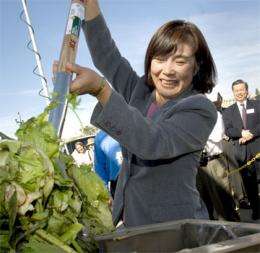Researcher's waste-to-energy technology moves from the lab to the marketplace

(Phys.org) -- Technology invented by a University of California, Davis, researcher that converts solid waste into renewable energy is debuting today as the first commercially available, high-solid anaerobic digestion system in the United States.
Ruihong Zhang, a UC Davis professor of biological and agricultural engineering, has been working on her anaerobic digester technology for the past decade, bringing it from the laboratory to the pilot stage in 2006. When Clean World Partners, a Sacramento-based startup that licensed the technology from UC Davis, unveils the biodigester today at a Sacramento, Calif., packaging company, it will mark the first time her research has reached the market.
“I applaud Professor Zhang for this tremendous accomplishment," said UC Davis Chancellor Linda P.B. Katehi. "Scientists like Professor Zhang are helping UC Davis address the most pressing global problems of our time. Her work brings us a giant step closer to the sustainable future we all hope for.”
The anaerobic digestion system is located at American River Packaging. It will convert 7.5 tons per day of food waste from regional food producers, including Campbell’s Soup Company, and a half ton each day of unrecyclable corrugated material from ARP into natural gas. The system will generate roughly 1,300 kWh of renewable energy per day, meeting about 37 percent of ARP’s electricity needs and preventing an estimated 2,900 tons of waste from entering landfills each year. The project has created about 22 jobs.
“This kind of project and technology is actually changing how societies treat and view waste as a resource, which, overall, leads to a better world, a cleaner environment and new jobs,” said Zhang.
Anaerobic digestion relies on bacteria to break down biodegradable waste material in the absence of oxygen. Zhang’s system turns that waste into such valuable byproducts as renewable energy, compost, water, and natural fertilizer. While anaerobic digestion is not a new technology in itself, operational and material-handling limitations had prevented its commercial adoption.
Unlike most other digesters that primarily treat liquid waste, such as manure from dairy farms and municipal wastewater, Zhang’s high-rate digester technology can convert both liquid and solid waste, including food waste, yard waste, plant residues, paper and cardboard.
Zhang also sought to overcome two key barriers to the widespread use of anaerobic digesters: time and money. The new technology makes such waste conversion systems replicable, with many components prefabricated, reducing the time it takes to build them. For example, the Clean World Partners system at ARP went from bare ground to energy production within 90 days and cost about $2 million to $3 million.
Zhang’s system also turns waste into energy in half the time of other digesters and produces more gases that can be turned into clean energy. These efficiency improvements are expected to drive down cost and maximize the amount of energy produced and the volume of waste diverted from the landfill.
Clean World Partners formed in 2009 to commercialize Zhang’s anaerobic digestion technology and bring it to a wider market. The company plans to open a second waste conversion facility using Zhang’s technology at Sacramento County’s south area transfer station in June.
“Ruihong’s contributions continue to be critical to our success as a key adviser,” said Clean World Partners CEO Michele Wong, a UC Davis alumna. “We are proud to work with UC Davis and Ruihong to commercialize these technologies.”
The anaerobic digestion facility was first developed and tested as a pilot plant at UC Davis. The university is currently working with Clean World Partners to bring a full-scale biodigester to campus. Though still in the planning stages, that biodigester is expected to help UC Davis West Village, the nation’s largest planned zero-net-energy community achieve its goal of generating as much power as it consumes in the course of a year.
Provided by UC Davis



















